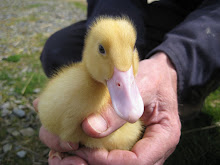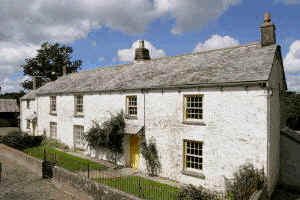 This
This is something a friend told me about, and well, I struggled to believe her. But now I've seen it for myself.
It's been around for some years now, but even though the South West has more farms than anywhere else in the country, there are just 20 robot milking parlours in the whole region.
What's it all about then?
Basically, the cow determines when it wants milking (aided by greed as the robot supplies food too), and hops onto the unit which then takes control with no-one needing to be present. First the computer notes which cow it has in its clutches from the transmitter hung round her neck. The gate closes to keep her secure, and a warm steamy wash with clever little rollers brushes up and down each teat, just like a miniature car wash. Seeing it in action last night at a local farm I suggested that particular function might have been invented by
Ann Summers. Next, the laser comes into action to precisely determine where the teats are before docking the cups to them. If the cow shifts a little, the lasers recalibrate and have another go. If only 3 quarters are in action, the computer knows that too. Then the milking starts. Each quarter of the udder is milked independently, so the machine stops milking each one when it is empty. Meanwhile, the computer is analysing just about everything: milk flow; temperature; quantity of milk produced from each quarter; number of times the cow has presented herself for milking; whether the cow is about to come down with
mastitis; if it's been milked a couple of hours ago and needs shoving out and not milking; you name it.
The cows take themselves through a non return gate when they want a little steaming, brushing and milking, otherwise they are free to help themselves elsewhere in the cow shed to feed, a lie down or a relaxing scratch from the
automatic cow brush. Although the farm I visited keeps the cows indoors, you can certainly include
fresh grazing into the system by enabling recently milked cows access to outdoor grazing.
It was an incredibly intelligent system, requiring minimal labour, and providing the farmer with everything you need to know about your cow, enabling swift preventative care. It also sends phone alerts if there is a problem of any kind, with clear messages that describes exactly what requires attention. Up to a week is needed to acclimatise each cow, and the system clearly produces very quiet cows and gives them almost everything they need.
But although I was in awe of it all, I don't want milk from cows excluded from spring and summer natural grazing, and I'd like to see for myself a system that includes significant access to grass even if it creates a slight decrease in the milk yield. I wonder what the
Soil Association view is on this.
If you are intrigued and want to see the system in action, you can watch a video
here.
 My wonderful old cat had to be put to sleep a couple of months back. He was very ill but had been chirpy and content til the last handful of hours when it was finally time to intervene. I had hoped to find him permanently asleep on his cushion, but he just wouldn't drift off on his own, and he was clearly feeling really bad. They say you know when it's time, and I did.
My wonderful old cat had to be put to sleep a couple of months back. He was very ill but had been chirpy and content til the last handful of hours when it was finally time to intervene. I had hoped to find him permanently asleep on his cushion, but he just wouldn't drift off on his own, and he was clearly feeling really bad. They say you know when it's time, and I did.
































